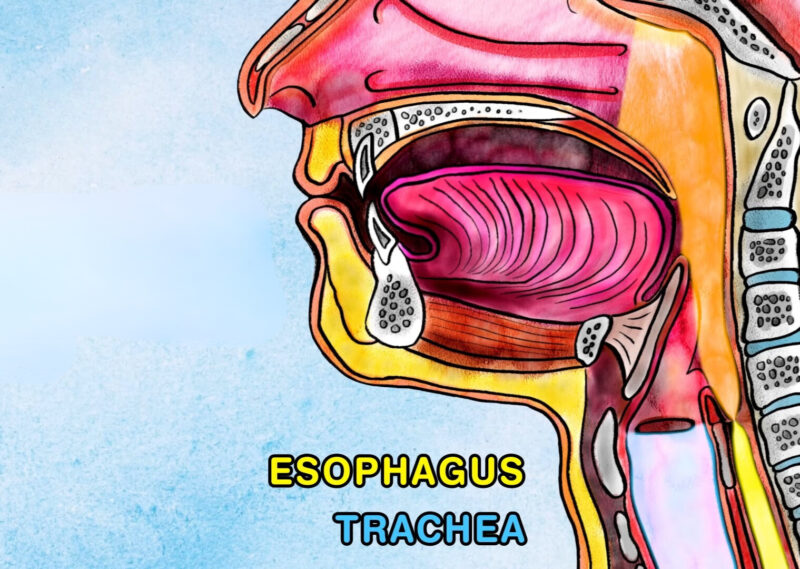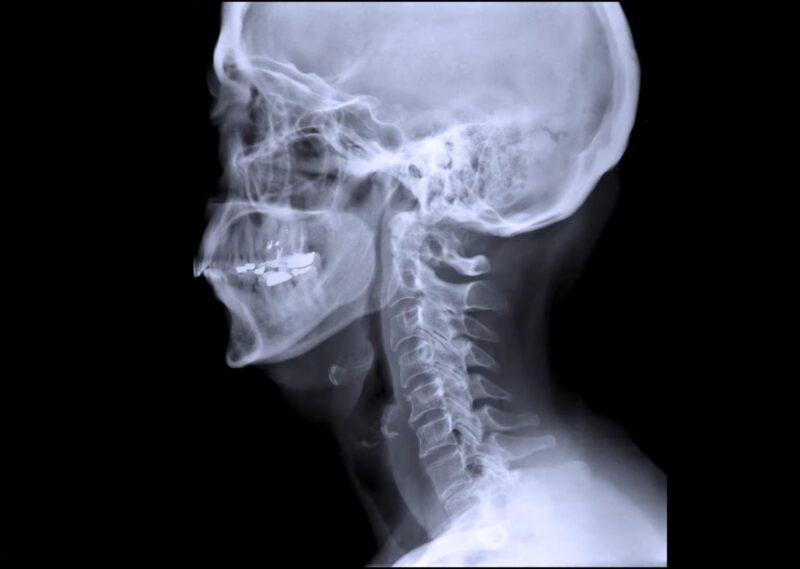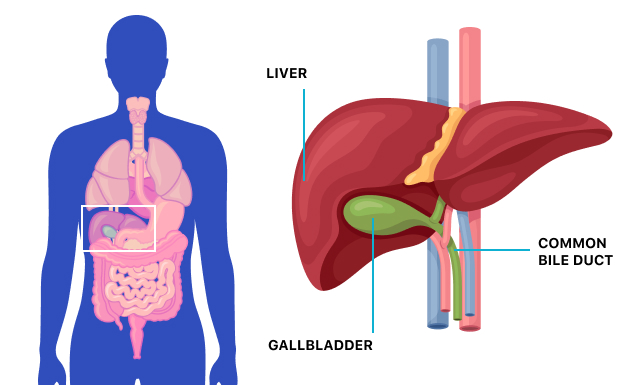The human body comprises numerous organs, each performing specific and vital functions. Among these, the esophagus and the windpipe are two crucial structures often misunderstood due to their proximity in the neck. This article aims to clarify the differences between these two anatomical structures.
Basic Anatomy and Location

Esophagus: The esophagus is a muscular tube that transports food from the mouth to the stomach. It starts at the pharynx, located at the back of the throat, and extends down to the stomach. The esophagus lies behind the trachea (windpipe) and the heart, and in front of the spine. It measures about 25 centimeters (10 inches) in adults.
Windpipe (Trachea): The trachea, commonly known as the windpipe, is the air passage that connects the larynx (voice box) to the lungs. It is located in front of the esophagus and extends from the larynx in the neck to the bronchi in the chest. The trachea is about 10 to 15 centimeters (4 to 6 inches) long in adults and is made up of around 15-20 C-shaped rings of cartilage, which provide structure and prevent collapse during breathing.
Function and Role
Esophagus: The primary function of the esophagus is to convey food and liquids from the mouth to the stomach. When food is swallowed, it enters the esophagus, where rhythmic, wave-like muscle contractions called peristalsis help move the food downward. Additionally, the esophagus plays a role in preventing the backflow of stomach contents by having a sphincter (a ring-like muscle) at its lower end, which opens to let food into the stomach and closes to prevent gastric acids from coming up.
Windpipe: The windpipe’s main function is to provide a path for air to reach the lungs. When we breathe in, air travels through the nose or mouth, passes the larynx, and goes down the trachea into the bronchi and lungs. The trachea also plays a crucial role in warming and humidifying the air before it reaches the lungs. The c-shaped cartilage rings ensure the trachea remains open to allow free passage of air.
Structural Differences
Esophagus: The esophagus is a muscular tube made up of several layers, including mucosa, submucosa, muscularis, and adventitia. These layers help in the smooth passage of food and also maintain the structural integrity of the esophagus.
Windpipe: The trachea’s structure is distinct with its C-shaped rings of hyaline cartilage, which are connected by muscles and ligaments. The inside of the trachea is lined with a mucous membrane, containing cells with tiny hair-like projections called cilia. These cilia trap and expel dust and other foreign particles from the air, keeping the lungs clean.
Pathological Conditions
Esophagus: Various conditions can affect the esophagus, including gastroesophageal reflux disease (GERD), esophagitis, Barrett’s esophagus, esophageal cancer, and achalasia. These conditions can cause symptoms like heartburn, difficulty swallowing, and chest pain.
Windpipe: The trachea can be affected by conditions such as tracheitis, tracheal stenosis, tracheomalacia, and tracheal tumors. Symptoms of tracheal disorders may include coughing, wheezing, shortness of breath, and stridor (a high-pitched breathing sound).
Diagnostic and Treatment Approaches

Esophagus: Diagnostic methods for esophageal disorders include endoscopy, barium swallow, and esophageal manometry. Treatments vary based on the condition and may involve medications, lifestyle changes, or surgery.
Windpipe: For tracheal conditions, diagnosis often involves imaging tests like X-rays, CT scans, or MRI, and sometimes bronchoscopy. Treatment can range from medications and breathing therapies to surgical interventions in more severe cases.
Prevention and Care
Maintaining the health of both the esophagus and the windpipe involves similar general health practices. These include avoiding smoking, managing acid reflux, maintaining a healthy diet, and seeking timely medical attention for persistent symptoms like coughing, difficulty swallowing, or chest pain.
Importance in Bodily Functions
The role of the esophagus and the windpipe extends beyond their primary functions of transporting food and air. They are integral to the efficient functioning of the digestive and respiratory systems, respectively, and any disruption in their function can have wide-ranging effects on overall health.
Esophagus: The esophagus ensures the smooth passage of food, which is essential for proper digestion and nutrient absorption. Disorders of the esophagus can lead to malnutrition, weight loss, and, in severe cases, can increase the risk of aspiration pneumonia, where food enters the respiratory tract.
Windpipe: The windpipe’s role in air conduction is vital for effective gas exchange in the lungs. Any obstruction or narrowing of the trachea can significantly impair breathing, reducing oxygen supply to the body, which can be life-threatening in acute cases.
Interaction and Coordination
While the esophagus and windpipe are separate structures, their proximity means they must coordinate closely, especially during swallowing. This coordination is crucial to prevent food from entering the windpipe, which can lead to choking.
Swallowing Reflex: When swallowing, the larynx elevates, and the epiglottis, a flap of tissue, covers the entrance to the windpipe to direct food into the esophagus. This reflexive action is essential to ensure that food and liquid enter the esophagus and not the windpipe.
Developmental Aspects
The development of the esophagus and the windpipe in the embryonic stage is a complex process. Abnormalities in the development can lead to congenital conditions such as esophageal atresia (where the esophagus does not develop properly) or tracheoesophageal fistula (an abnormal connection between the esophagus and the trachea). These conditions require surgical intervention soon after birth.
Research and Advances
Ongoing research in the fields of gastroenterology and respiratory medicine continues to shed light on the esophagus and windpipe. Advances in medical technology, such as improved endoscopic techniques and tracheal stenting, have enhanced the diagnosis and treatment of conditions affecting these structures.
FAQs
Can lifestyle choices affect the health of both the esophagus and the windpipe?
Yes, lifestyle choices can significantly impact the health of both the esophagus and the windpipe. Smoking, for instance, can damage the cilia in the trachea and increase the risk of esophageal cancer. Similarly, excessive alcohol consumption can lead to inflammation in both the esophagus and the respiratory tract.
Are there any common symptoms that might indicate problems with either the esophagus or the windpipe?
Common symptoms that could indicate problems with the esophagus or the windpipe include persistent coughing, difficulty swallowing (dysphagia), heartburn, recurrent pneumonia, wheezing, and hoarseness. Any of these symptoms warrant a consultation with a healthcare provider.
How can one differentiate between a problem in the esophagus and an issue in the windpipe?
While some symptoms may overlap, certain signs can help differentiate between esophageal and windpipe issues. For example, frequent heartburn and pain while swallowing are more indicative of esophageal problems, whereas wheezing and shortness of breath are typically associated with windpipe issues.
Can allergies affect both the esophagus and the windpipe?
Allergies can indeed affect both the esophagus and the windpipe. Allergic reactions can lead to inflammation in the windpipe, causing respiratory symptoms. In the esophagus, allergies can result in a condition known as eosinophilic esophagitis, which causes inflammation and difficulty swallowing.
Is it possible to have disorders that affect both the esophagus and the windpipe simultaneously?
Yes, certain conditions can affect both the esophagus and the windpipe. For example, gastroesophageal reflux disease (GERD) can cause stomach acid to enter the esophagus and sometimes the windpipe, leading to symptoms affecting both organs.
What role does diet play in maintaining the health of the esophagus and the windpipe?
Diet plays a significant role in the health of both the esophagus and the windpipe. A balanced diet rich in fruits, vegetables, and whole grains can reduce the risk of esophageal issues. For the windpipe, avoiding irritants like spicy foods and acidic beverages can help prevent irritation and inflammation.
Final Words
The esophagus and the windpipe, while often confused due to their close anatomical relationship, are distinctly different in their structure, function, and the medical issues they encounter.
Understanding these differences is not only critical for medical professionals but also for individuals to recognize symptoms indicative of disorders in these organs. Regular health check-ups and being attentive to the body’s signals can go a long way in maintaining the health of these vital structures.
